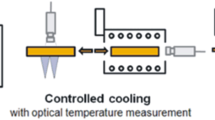Abstract
To properly model the cracking susceptibility during solidification under continuous casting conditions, it is essential to have accurate data. Such data for the mechanical properties of steel during solidification are scarce if not non-existent. An experimental tool called the Mold Cracking Simulator (MCS) has been used to simulate the initial shell formation under continuous casting conditions. As part of the test, the shell is mechanically subjected to deformation. A mathematical model has been developed to translate the force and elongation measured during the MCS trials into stress–strain components. To test the model and validate the assumptions, two steel grades were tested, a peritectic steel grade and a higher-alloyed grade. The results show that the reproducibility of the test is very good and the stress–strain curves are consistent with the steel composition. Moreover, the metallographic and fractographic analysis of the deformed MCS samples shows that the microstructure is comparable to that of a continuously cast product and the cracks generated are interdendritic, i.e., hot tears.













Similar content being viewed by others
Abbreviations
- T S :
-
Solidus temperature (°C)
- T L :
-
Liquidus temperature (°C)
- L :
-
Length of the wedge (19.9 mm)
- d mold :
-
Diameter of the mold (69.36 mm)
- θ :
-
Angle of the curved inclined surface
- R :
-
Radius of solidified shell in (mm)
- t :
-
Thickness of the solidified shell in (mm)
- F N :
-
Normal force perpendicular to the incline plane (N)
- F w :
-
Load transmitted by wedge on to the shell (N)
- F S :
-
Sliding force along the inclined plane (N)
- ∆F :
-
Difference between forces measured during hot test and cold test (N)
- dy :
-
Incremental displacement in positive longitudinal direction, i.e., from A to AI
- dx :
-
Incremental displacement in radial direction from B to BI (refer Figure 4)
- \( \dot{\varepsilon } \) :
-
Strain rate, change in strain of a material with respect to time (1/s)
- σ p :
-
Peak stress (MPa)
- \( \dot{\varepsilon }_{p} \) :
-
Strain at Peak stress (pct)
- ε θθ , ε rr, and ε zz :
-
Normal strains measured along the radial, tangential, and axial directions, respectively (elongation/shortening of material per unit length)
- σ θθ, σ rr, and σ zz :
-
Normal stress along the radial, tangential, and axial directions, respectively (force per unit area)
- τ θθ, τ θz, and τ zr :
-
Shear stress, components of stress coplanar with a material cross section (force per unit area)
References
K.O. Yu, ed., Modelling for casting and solidification processing, vol. 1. New York: Marcel Dekker, 2009.
[2] W. T. J. Lankford, Metall. Trans., vol. 3, 1972, pp. 1331–1356.
[3] H. Mizukami, A. Yamanaka, and T. Watanabe, ISIJ Int., vol. 42, no. 9, 2002, pp. 964–973.
[4] T. Nakagawa, T. Umeda, J. Murata, and Y. Kamimura, ISIJ Int., vol. 35, No. 6, 1995, pp. 723–729.
[5] B. Mintz, J. R. Wilcox, and D. N. Crowther, Mater. Sci. Technol., vol. 2, no. 6, 1986, pp. 589–594.
[6] C. Bernhard, H. Hiebler, and M. M. Wolf, ISIJ Int., vol. 36, 1996, pp. 163–166.
[7] H. Presslinger et al., ISIJ Int., vol. 46, no. 12, pp. 1845–1851, 2006.
H. Yasunaka, T. Mori, H. Nakata, F. Kamei, and S. Harada: Steelmak. Process., 1986 (69), pp. 497–502.
H. G. SUZUKI, S. Nishimura, and Y. NAKAMURA, Trans. iron steel Inst. Japan, vol. 24, no. 1, 1984, pp. 54–59.
10.B. Rogberg: Scand. J. Metall., 1983, vol 12, pp. 51–66.
K. Hansson: Ph.D. Thesis, Royal Institute of Technology, Stockholm, Sweden, 2001.
T.T. Natarajan, T.J. Piccone, K.D. Powers, C.C. Snyder, A. Badri, and A.W. Cramb: AISTech2004, 2004, vol. II, pp. 1013–25.
P. Kozlowski, Thomas B.G., J. Azzi, and Wang H.: Metall. Trans. A, vol. 23A, 1992, pp. 903–18.
H. Zhang, Y. Wang, W. Zhang: Metall. Mater. Trans .B, vol. 47B, 2016, pp. 2244–2252.
[15] P. Ackermann, W. Kurz, and W. Heinemann, Mater. Sci. Eng., vol. 75, no. 1, 1985, pp. 79–86.
C. Bernhard, R. Pierer, and S. Michelic: AISTech, 2010, pp. 977–86.
B. Santillana and M. Cruijff: WO patent request, 2011.
[18] G. E.Dieter, Mechanical Metallurgy, vol. SI metric. McGraw-Hill Book Co. UK LTD, 1998.
B. Santillana, B.G. Thomas, A. Hamoen, L.C. Hibbeler, A. Kamperman, and W. Van Der Knoop, AISTech - Iron and Steel Technology Conference Proceedings, 2007, vol. 2, CD-Rom.
B.G. Thomas, A. Moitra, and H. Zhu, Miner. Met. Mater. Soc. 1995, pp. 240–49.
[21] V. Vullo, Circular cylinders and pressure vessels. Stress Analysis and Design, Springer s. Springer-Verlag - Berlin, 2014.
B. Santillana, B.G. Thomas, G. Botman, and E. Dekker: in 7th European Continuous Casting Conference, 2012.
23.Suzuki T, Yu CH, Emi T (1997) ISIJ Int. 37(4), 375–382.
C. Bernhard, H. Hiebler, and M.M. Wolf: La Rev. Metallurgie, 2000, pp. 333–43.
[25] L. Arnberg and R. H. Mathiesen, JOM, vol. 59, no. 8, 2007, pp. 20–26.
B. Santillana: Ph.D. Thesis TU Delft, 2013.
[27] M. Easton and D. Stjohn, Metall. Mater. Trans. A, vol. 36, no. 7, 2005, pp. 1911–1920.
[28] Y. Meng and B. G. Thomas, Metall. Mater. Trans. B, vol 34B, 2003, pp. 707-725.
Author information
Authors and Affiliations
Corresponding author
Additional information
Manuscript submitted November 3, 2017.
Rights and permissions
About this article
Cite this article
Santillana, B., Paruchuri, V., Kripak, V. et al. Assessment of Shell Strength During Solidification in the Mold Cracking Simulator (MCS) Test. Metall Mater Trans A 50, 142–150 (2019). https://doi.org/10.1007/s11661-018-4958-8
Received:
Published:
Issue Date:
DOI: https://doi.org/10.1007/s11661-018-4958-8




